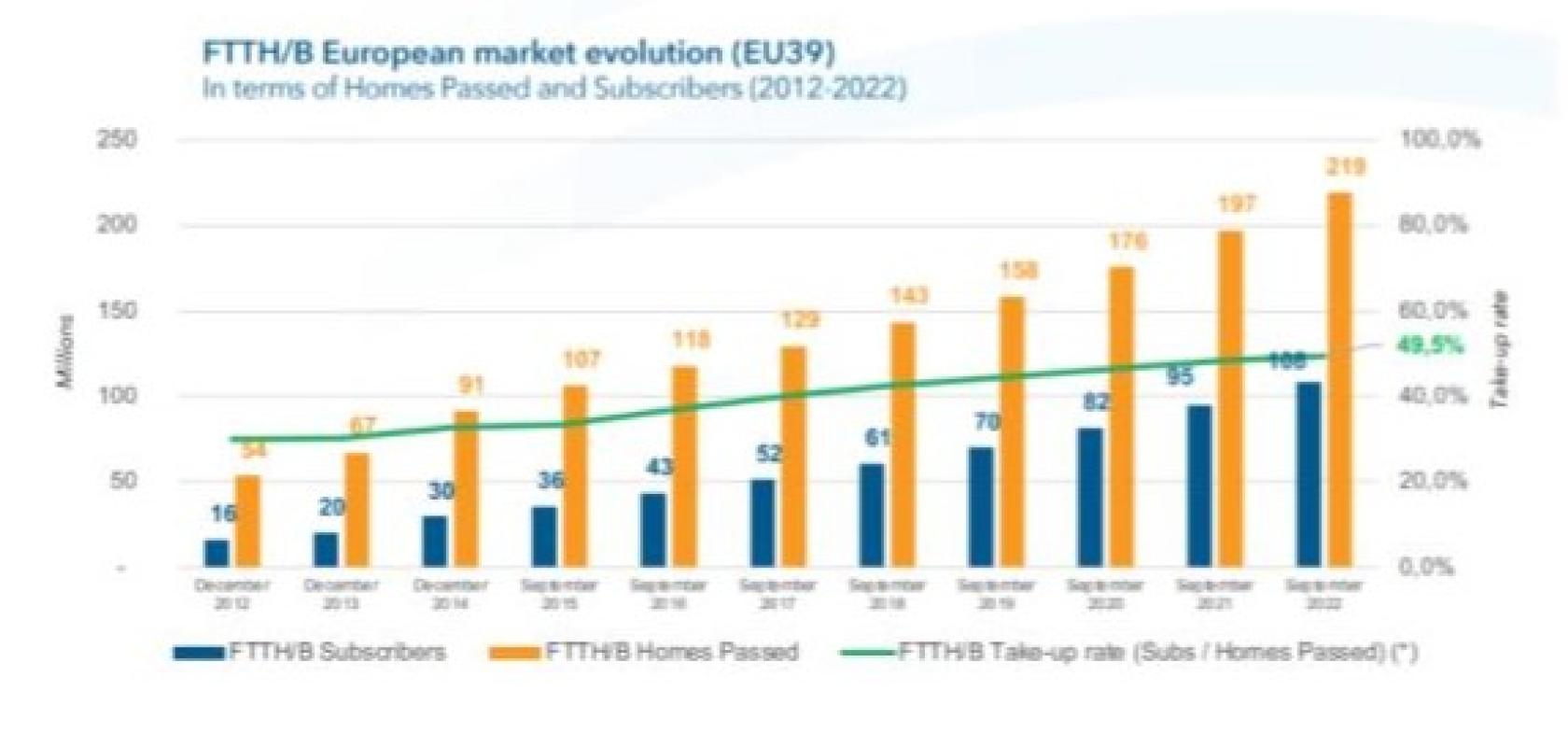The FTTH Council Europe has revealed its latest market reports at the FTTH Conference in Madrid.
According to the latest Market Panorama report, conducted for the council by iDate, the total number of homes passed with FTTH/B in the EU39* reached 219 million homes in September 2022, compared to nearly 198.4 million in September 2021.
The biggest growth markets in terms of homes passed in absolute numbers are the United Kingdom (+4.2 million), France (+3.5 million), Turkey (+2.9 million), and Italy (+2.1 million).
The top five countries in terms of annual growth rates for homes passed are Belgium (+60%), the United Kingdom (+51%), Serbia (+40%), The Netherlands (+34.7%), and Greece (+34.5%). FTTH/B coverage rate in EU39 now amounts to 62.2% (up by 5 percentage points vs 2021) and coverage rate in the EU27+UK officially surpasses half of total homes – 55.1% (vs 48.5% from 2021). The council says that this data re-confirms the continuous upward trend observed for several years in a row now.
When it comes to subscribers, the report detailed that numbers in the EU39 region reached 108 million. The five fastest growing markets in terms of new subscribers were France (+3.3 million), United Kingdom (+1.5 million), Spain (+1.1 million), Turkey (+898), and Italy (+822).
By September 2022, the EU39 FTTH/B take-up rate (subscribers as a proportion of homes passed) rose to 49.5% (up by 1% from the previous year). This, said the council, is a clear indication that, despite the progress being made, there is still a huge gap between fibre coverage and adoption, as demonstrated by the even slower progress in the EU27+UK, where the take-up rate only rose by 0.4% (reaching 52.8%).
Overall, the report observes an increasing contribution from incumbent operators to FTTH/B coverage figures, with around 56% of the total homes in the EU39 being passed by alternative ISPs and around 39% by the incumbent ISPs, and the remaining 4% being municipalities/utilities. Alternative operators’ initiatives are still dominant, but incumbents are starting to close the gap.
In terms of the homes still to be covered, Germany, the United Kingdom, and Italy are cited as the countries with the most work left to be done. Altogether, 89 million homes are still not connected to FTTH/B networks, accounting for 55% of the total EU27 household without a subscription.
Looking at a wider global market, the FTTH Council Europe also revealed the global market rankings, an initiative of the FTTH Councils Global Alliance. The data reveals that 22 countries have achieved penetration rates higher than 50%. The UAE leads the way here with 98.1%, while Qatar reached the second position at 97.8% (vs 84% from the previous year). Singapore (96.5%), Hong Kong (91.6%), and China (89.4%) complete the top five positions.
In the European region, for the fourth consecutive year in a row, Iceland tops the European FTTH/B penetration ranking with a 76.8% penetration rate. It is followed by Spain (73.5%) and Portugal (71.1%). Seven countries passed the 50% penetration rate mark (Iceland, Spain, Portugal, Sweden, Norway, Romania, France).
In addition to the above-mentioned market reports, the FTTH Council Europe also revealed the results of its FTTH/B Forecasts for Europe 2023-2028 and FTTH/B in Rural Areas 2023 reports. The new FTTH/B Investments Tracker report was additionally launched, as an initiative of the Investors Committee powered by Macquarie Group Limited, alongside revamped editions of the industry-known FTTH Handbook and In-Home Broadband Excellence Guide.
Eric Festraets, President of the FTTH Council Europe said of the figures: “The most recent market figures show that we are on the right track to achieve the ambitious connectivity targets set by the European Commission for 2030. However, the data demonstrate that efforts are still required to convince subscribers to choose fibre. Take-up rates are too low in many countries and demand drivers are multiple and complex, and require attention from policymakers as well as service providers. We rely on policymakers to support the rollout in areas where there is no viable commercial business case and encourage governments and regulators to keep on creating an environment which is favourable to healthy competition and attractive for private investors."
* EU39: EU27 countries + United Kingdom, 4 CIS countries (including Kazakhstan and Ukraine), and also Iceland, Israel, North Macedonia, Norway, Serbia, Switzerland and Turkey


